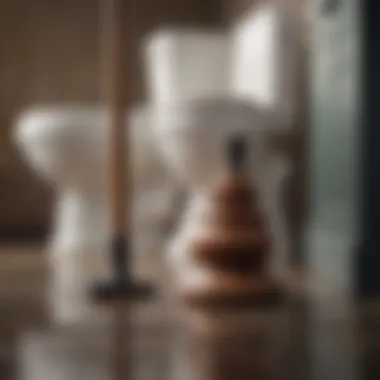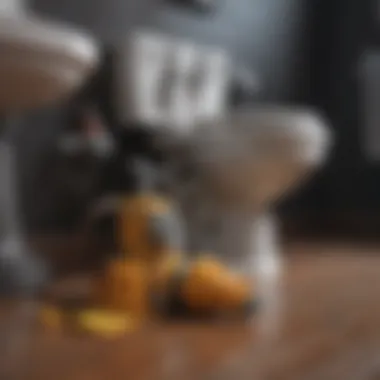Techniques for Unclogging a Clogged Commode


Intro
Being equipped with the right knowledge and tools is essential for tackling this issue efficiently. Whether one is dealing with a minor blockage or a more complex situation, a systematic approach can make the task manageable. In addition, understanding the underlying causes of clogs can guide users in preventing future occurrences.
With an eye on safety and environmental considerations, this guide intends to help navigate the intricacies of plumbing challenges. Readers will find clear instructions and insights that support both immediate remedies and longer-term prevention strategies.
Preamble to Clogged Commodes
Clogged toilets represent a common nuisance in households, affecting residents’ daily routines and causing undue stress. Understanding how toilets work, along with the factors leading to clogs, is crucial for effectively addressing these problems. This section brings attention to the mechanics of commodes and the main reasons they malfunction, paving the way for strategies to maintain functionality and cleanliness.
Understanding the Mechanics of a Toilet
A toilet functions through a relatively simple mechanism, but it relies on several components working in harmony. Typically, a toilet includes a bowl, a tank, a flush handle, and a trap. When you flush, water from the tank rushes into the bowl, creating a siphon effect that pulls waste down through the drain and into the plumbing system.
The design of the trap is especially important. Its purpose is to hold a small amount of water, which prevents sewer gases from entering the home. If something disrupts this mechanism, such as a blockage in the trap or drain lines, the toilet may clog, leading to overflowing and unpleasant odors. Understanding these components helps isolate areas where problems may arise, allowing for efficient problem-solving.
Common Causes of Clogs
Many factors contribute to clogged toilets, necessitating an understanding of each. Common causes include:
- Excessive Toilet Paper Usage: Using too much toilet paper can quickly lead to blockages.
- Foreign Objects: Items not meant for flushing, like toiletries, wipes, or toys, can cause severe clogs.
- Tree Roots: In older homes, tree roots can invade sewer lines, leading to significant drainage issues.
- Hard Water Deposits: Mineral build-up over time can restrict flow and contribute to clogs.
- Improper Installation: Sometimes, the initial setup of the toilet can affect drainage efficiency.
Recognizing these causes allows homeowners to adopt preventative measures. By understanding why clogs happen, one can take proactive steps to minimize disruption and maintain a well-functioning commode.
Initial Assessment and Diagnosis
When facing a clogged commode, understanding the problem before applying potential solutions is critical. The initial assessment and diagnosis stage is essential as it lays the groundwork for effective unclogging methods. By evaluating the severity and nature of the clog, one can choose the most appropriate tools and techniques. This not only saves time but also helps in avoiding unnecessary damage to plumbing systems or potential health hazards.
Identifying the Severity of the Clog
To begin, it is necessary to identify how severe the clog is. Different types of clogs require different approaches. A mild clog might only need a plunger, while a more severe blockage may necessitate advanced tools like a toilet auger. Here are a few signs to look for that can help in assessing the severity:
- Water Level: If the water level in the toilet bowl is unusually high or low, it might indicate the type of clog. High levels typically suggest a significant blockage, whereas low levels may indicate a minor obstruction.
- Flushing Behavior: If the toilet struggles to flush or makes unusual noises, it could mean that the clog is partially obstructing the drainage. Monitoring how the toilet behaves during a flush can provide clues.
- Odors: Foul smells can indicate organic material that is decomposing within your pipes, hinting that it might be a more complex issue needing swift attention.
Understanding these factors enables you to determine whether the situation is one you can handle or if it’s something that requires professional assistance.
Determining if Professional Help is Needed
Once you have assessed the severity of the clog, the next step is deciding if professional help is required. There are situations where attempting a DIY method may lead to further complications. Here are some considerations:
- Duration of the Clog: If the toilet remains clogged after multiple attempts to fix it over a few days, it is advisable to contact a plumber. Persistent blockages can cause greater issues down the line.
- Tools and Techniques: If you do not have access to advanced tools like a toilet auger or are unfamiliar with using them, seeking professional services is wise. Some clogs may be located deeper within the plumbing, which requires specialized equipment.
- Health Risks: Dealing with sewage backups or hazardous clogs can pose health risks. If the clog is causing sewage to back up into your home, do not hesitate to contact professionals.
In summary, the initial assessment and diagnosis not only prepare you for the task ahead but also help ensure safety and effectiveness in dealing with clogged commodes. Taking the time to understand the situation can often lead to a more successful resolution.
Basic Tools Required for Unclogging
To effectively address a clogged toilet, having the right tools is essential. This section will outline the primary tools necessary for unclogging, emphasizing their importance and how each can contribute to resolving the issue efficiently. When equipped with the right tools, homeowners can often tackle clogs without the need for professional help, saving both time and money.


Using a Plunger Effectively
A plunger is perhaps the most recognized tool in plumbing. Its effectiveness lies in its simple design, which generates suction and pressure. To use a plunger effectively, one must ensure that it creates a tight seal around the toilet drain. This involves pushing down firmly and then pulling up sharply to create a vacuum. Repeat this action several times. Many people overlook the importance of a good quality plunger; using a flange plunger, designed specifically for toilets, can enhance effectiveness further.
Tip: Always make sure the toilet bowl has enough water for the plunger to work properly; too little water can reduce effectiveness.
Incorporating a Toilet Auger
A toilet auger is a specialized tool designed to break up clogs that a plunger cannot tackle. It consists of a long flexible metal wire with a coiled end that can reach deep into the toilet trap. When using a toilet auger, feed the auger into the drain until you encounter resistance, which often indicates a clog. Rotate the handle to break the obstruction or pull it out. This tool is particularly useful when dealing with persistent clogs that do not respond to plunging, allowing for a more thorough approach.
Utilizing Chemical Drain Cleaners
While mechanical tools are often preferred, chemical drain cleaners serve as a supplemental option. They contain powerful ingredients designed to dissolve organic material and clear clogs. It is important to select cleaners specifically formulated for toilets, as some can damage plumbing fixtures. Use these products sparingly, following the manufacturer's instructions. Keep safety in mind; always use gloves and ensure proper ventilation when applying chemical cleaners, as they can be hazardous if mishandled.
Step-by-Step Unclogging Process
The unclogging process is crucial when dealing with a clogged toilet. Each step contributes significantly towards restoring functionality. Addressing a toilet that refuses to flush can be frustrating. However, following a systematic approach eases this task. By understanding the sequence of actions needed, you can save time and effort. This section covers essential steps to unclogging a commode effectively.
Preparing the Area
Before diving into the unclogging task, it is essential to prepare the area appropriately. Gather necessary tools and supplies nearby. These typically include a plunger, toilet auger, rags, and protective gloves. Ensuring you have everything at hand reduces disruptions during the process.
Don protective equipment, especially gloves, to maintain hygiene. Remove any obstructive items around the toilet to create a clean workspace. You may also want to consider placing towels on the floor. This helps to absorb any spills that might occur. Preparing the area not only enhances safety but also makes the process more efficient.
Applying the Plunger
Holding the plunger correctly is vital for effective clog removal. It is necessary to use a flange plunger, specifically designed for toilets. Position the plunger into the bowl, ensuring it covers the drain opening completely.
Firmly push down, then pull up quickly. This technique creates suction that dislodges the blockage. Repeat this action steadily for about 15 to 20 seconds. Sometimes it may take multiple attempts before the clog releases. Be persistent but gentle to avoid damaging the toilet.
Consistency and proper technique are more effective than sheer force.
Inserting the Toilet Auger
If plunging fails to resolve the issue, a toilet auger is your next tool. This device is designed to reach deeper clogs within the drain. Start by slowly inserting the auger into the toilet bowl, ensuring you do not scratch the ceramic. Turn the handle to extend the cable and probe the blockage. Once you feel resistance, turn the auger back and forth gently.
As you maneuver, the auger can break up the clog or hook onto it, allowing for easier removal. Be cautious while using it; forceful actions may harm the toilet's interior. This method is highly effective for stubborn clogs that a plunger cannot reach.
Using Chemical Cleaners Appropriately
Chemical drain cleaners can be useful but need to be used with caution. These products contain harsh substances that can damage pipes or toilets if not handled correctly. Always follow the manufacturer’s instructions and wear protective gear when using them.
Pour the recommended amount into the toilet bowl. Allow it time to sit as directed. After the designated time, flush the toilet to test if the blockage is cleared. If the clog persists, refrain from using more cleaner immediately. Instead, consider reevaluating the situation or seeking professional advice. Not all clogs respond to chemicals, and overuse can lead to significant plumbing issues.
By following these steps methodically, you can enhance the likelihood of successful clog removal. Understanding the unclogging process deepens your comprehension of toilet mechanics, ensuring you are better prepared for future occurrences.
Special Cases and Advanced Techniques
Understanding specific situations that may necessitate advanced techniques in unclogging a commode is essential. Not every clog can be resolved with basic tools like plungers or augers. Some clogs are more intricate and require an advanced approach. Recognizing when standard methods fall short can save time and prevent additional damage to plumbing systems. Assessing the circumstances correctly is the first step toward choosing the right technique.


Addressing Hard-to-Reach Clogs
Some clogs occur far down the drain line. These might not respond to traditional methods applied at the toilet bowl. When dealing with hard-to-reach clogs, it’s effective to take a step back and evaluate the plumbing layout. A toilet auger designed for deeper reach can be essential here.
It is advisable to:
- Inspect the pipe layout: Understand bends and angles that might trap debris.
- Use an inspection camera: This tool allows for visual confirmation of clogs within the drain. It provides insights about what is blocking the flow.
Proper positioning and technique can often dislodge hard-to-reach clogs without significant stress on plumbing.
When to Consider Hydro Jetting
Hydro jetting is an advanced technique employing high-pressure water to clear stubborn clogs. This method not only clears blockages but also cleans the interior of pipes. Consider hydro jetting if:
- Traditional methods fail: If plunging and augering have not resolved the issue, hydro jetting might be the next option.
- Frequent clogs are an issue: Regular issues could indicate a deeper problem in the plumbing system.
Hydro jetting can be a proactive approach, preventing future clogs by thoroughly cleaning pipes.
It’s important to note that this technique requires specialized equipment and should typically be performed by professionals. Misuse could damage the plumbing system.
Considering Professional Drain Services
Utilizing professional services can be a wise decision for severe plumbing issues. Experts can diagnose problems that untrained individuals might overlook. When to involve professionals includes:
- Recurring clogs: Frequent issues signal issues beyond simple blockages.
- Major leaks or backups: These can indicate severe plumbing problems needing professional assessment.
- Uncertainty in how to proceed: When in doubt, consulting experts can prevent errors and additional damage.
Experts often bring advanced tools and the know-how to address plumbing problems effectively. They can also provide recommendations for maintaining system health, ensuring long-term use.
Each of these advanced techniques and considerations plays a vital role in effective commode management. Combining basic knowledge and techniques with the readiness to escalate to advanced solutions forms a comprehensive approach to plumbing maintenance.
Preventative Measures
Preventative measures play a crucial role in maintaining a functional and efficient toilet system. Understanding how to use a toilet correctly and establishing a routine for inspections can minimize the likelihood of experiencing clogs. These measures not only preserve the plumbing infrastructure but also ensure a smoother daily operation of household facilities.
Education on Proper Toilet Use
Educating every household member on the appropriate use of the toilet is essential. Many clogs arise from improper disposal of waste or foreign objects. Here are key guidelines to follow:
- Only dispose of toilet paper: Teach users that only toilet paper should go down the toilet.
- Avoid flushing non-biodegradable items: This includes sanitary products, wipes, or any foreign objects.
- Use toilet in moderation: Excessive toilet use can increase strain on the system.
Establishing simple rules can significantly reduce clogging instances.
Regular Maintenance Schedules
Adopting a regular maintenance schedule fosters preventive care. This proactive approach helps identify potential problems before they escalate. Key elements include:
- Check for leaks: Inspect the toilet tank and bowl regularly for leaks.
- Inspect the flapper: Ensure the flapper in the tank is functioning properly to prevent water buildup.
- Clean the toilet: Regular cleaning helps prevent buildup that might lead to clogs.


Creating a monthly checklist simplifies the process, saving both time and money in the long run.
DIY Tips for Homeowners
Homeowners can engage in simple do-it-yourself techniques to enhance toilet function. Some notable tips include:
- Use enzymatic cleaners: These eco-friendly options reduce buildup without compromising plumbing.
- Flushing with vinegar: Occasionally flushing vinegar can break down limescale, aiding in smooth functionality.
- Avoid harsh chemicals: Many traditional drain cleaners may damage pipes; consider safer alternatives.
Regular preventative practices can avoid costly repairs and the inconvenience of clogs.
Environmental Considerations
Understanding the environmental implications of techniques to unclog a commode is vital for responsible plumbing practices. The impact of our cleaning habits can extend beyond immediate results, affecting plumbing systems, local ecosystems, and overall environmental health.
Impact of Chemical Cleaners on Plumbing
Chemical drain cleaners are commonly used to tackle stubborn clogs. However, these products often contain harsh substances such as sulfuric acid or sodium hydroxide. While effective in clearing blockages, they can cause damage to plumbing over time. This damage manifests as corrosion of pipes, particularly older systems made from materials like copper or galvanized steel. Additionally, these substances can contribute to environmental pollution if they leach into groundwater or local waterways during disposal and systemic failures.
- Risk of damage to pipes may lead to more significant issues down the line.
- Chemical residues can harm helpful bacteria in sewage treatment processes, negatively impacting waste processing and degrading water quality.
"Using chemical cleaners can turn a small clog into a larger plumbing issue that might necessitate expensive repairs or replacements."
Eco-Friendly Alternatives
Switching from traditional chemical cleaners to eco-friendly alternatives presents a more sustainable approach. These alternatives often utilize common household items like baking soda, vinegar, or even hot water. Here are some effective methods:
- Baking soda and vinegar: This combination creates a fizzy reaction that can break down minor clogs without harming plumbing. Pour half a cup of baking soda into the toilet bowl, followed by a cup of vinegar. Wait for about 30 minutes before flushing.
- Hot water: Pouring boiling water directly into the bowl can help soften blockages sufficiently, especially if combined with soap or dish detergent. It is essential to ensure the water is not placed directly into a porcelain toilet, as it may crack under sudden temperature changes.
- Biological cleaners: These products contain enzymes or bacteria that help break down waste and can be a safer option for pipes and the environment. They work without the harsh effects associated with chemical cleaners.
Implementing these eco-friendly options not only benefits plumbing systems but also aligns with a broader commitment to sustainability. Less harmful substances maintain water quality and reduce chemical runoff into the environment, which is increasingly crucial in today’s context of environmental consciousness.
End
In this article, we have navigated the multifaceted topic of unclogging a clogged commode. Understanding the intricacies of toilet functionality and the common culprits behind clogs is crucial for effective handling of plumbing issues.
The techniques discussed provide practical solutions, from basic to advanced methods. Whether employing a plunger, a toilet auger, or chemical drain cleaners, each approach has its own set of advantages and considerations. Ensuring that homeowners are informed about both the correct techniques and the tools needed empowers them to manage minor plumbing emergencies efficiently without unnecessary stress.
Furthermore, environmental considerations are critically important in today's world. Recognizing the impact of chemical cleaners on plumbing systems urges users to explore eco-friendly alternatives.
Summarizing Effective Techniques
The core techniques presented encompass a range of strategies for tackling a clogged commode. Here is a summary of the effective methods:
- Using a Plunger: A reliable first step, it requires proper techniques like maintaining a strong seal for maximum pressure.
- Toilet Auger: This tool can reach deeper clogs that a plunger cannot, providing a mechanical solution to stubborn blockages.
- Chemical Drain Cleaners: These should be used with caution to avoid damage to plumbing systems. Knowing how to apply these safely can prevent potential mishaps.
Each method is beneficial in its context. Homeowners should assess the severity of the clog before selecting an approach.
Encouragement for Safe Practices
Safety is paramount when dealing with plumbing tasks. Here are crucial safety practices to consider:
- Personal Protection: Always wear gloves and goggles to protect skin and eyes from splashes or harsh chemicals.
- Ventilation: Ensure the area is well-ventilated, especially when using chemical cleaners, to minimize inhalation of fumes.
- Read Labels: Before using any chemical product, reading the label thoroughly will familiarize users with proper usage and potential hazards.
By embracing these safe practices, individuals can approach unclogging tasks with confidence, mitigating risks associated with plumbing maintenance.
Ultimately, this article aims to equip readers with the knowledge and tools to address clogged commodes effectively while prioritizing safety and environmental consciousness.







